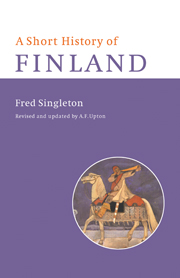Book contents
- Frontmatter
- Contents
- List of maps
- Dedication
- Preface
- 1 HISTORY OF FINLAND
- 2 FINLAND AND SWEDEN
- 3 FINLAND, SWEDEN AND RUSSIA IN THE EIGHTEENTH CENTURY
- 4 THE FINNISH NATIONAL AWAKENING
- 5 THE FINNISH ECONOMY IN THE NINETEENTH CENTURY
- 6 THE POLITICAL DEVELOPMENT OF FINLAND, 1863–I917
- 7 INDEPENDENT FINLAND
- 8 FINLAND IN THE SECOND WORLD WAR
- 9 FINLAND IN THE POST-WAR WORLD: THE POLITICAL SITUATION
- 10 THE ECONOMY OF FINLAND IN THE TWENTIETH CENTURY
- 11 THE SPIRIT OF FINLAND
- Appendices
- Bibliography by John J. Horton
- Index
10 - THE ECONOMY OF FINLAND IN THE TWENTIETH CENTURY
Published online by Cambridge University Press: 28 January 2010
- Frontmatter
- Contents
- List of maps
- Dedication
- Preface
- 1 HISTORY OF FINLAND
- 2 FINLAND AND SWEDEN
- 3 FINLAND, SWEDEN AND RUSSIA IN THE EIGHTEENTH CENTURY
- 4 THE FINNISH NATIONAL AWAKENING
- 5 THE FINNISH ECONOMY IN THE NINETEENTH CENTURY
- 6 THE POLITICAL DEVELOPMENT OF FINLAND, 1863–I917
- 7 INDEPENDENT FINLAND
- 8 FINLAND IN THE SECOND WORLD WAR
- 9 FINLAND IN THE POST-WAR WORLD: THE POLITICAL SITUATION
- 10 THE ECONOMY OF FINLAND IN THE TWENTIETH CENTURY
- 11 THE SPIRIT OF FINLAND
- Appendices
- Bibliography by John J. Horton
- Index
Summary
At the end of the Second World War the Finnish economy was seriously crippled. Apart from the losses in manpower and equipment which were directly attributable to the war, there was the disruption to foreign trade, which had begun in 1939, even before Finland itself was involved in the war. Its two major trading partners, Britain and Germany, were prevented by war from taking Finnish exports of timber and paper products. In 1939 over 40 per cent of imports came from Britain and Germany and the two belligerent powers bought between them over 50 per cent of Finland's exports. After the United States entered the war in 1941 the trickle of raw materials and fuel oil which had been brought through dried up completely. The textile industry lost its supply of raw cotton and although it was able to continue production for a time by using the stockpiles which had been built up; and although great ingenuity was shown in utilizing substitute materials, the industry was soon in crisis. As the war proceeded machinery began to wear out and could not be replaced. Some supplies for essential war industries were imported, with German permission, and Sweden was able to send a limited amount of iron ore. The cost of the war had imposed a heavy burden upon state finances and there was a large balance of payments deficit.
Apart from these deprivations, which were ‘normal’ to a wartime situation, there were certain special disabilities which Finland faced in 1945.
- Type
- Chapter
- Information
- A Short History of Finland , pp. 147 - 154Publisher: Cambridge University PressPrint publication year: 1998



